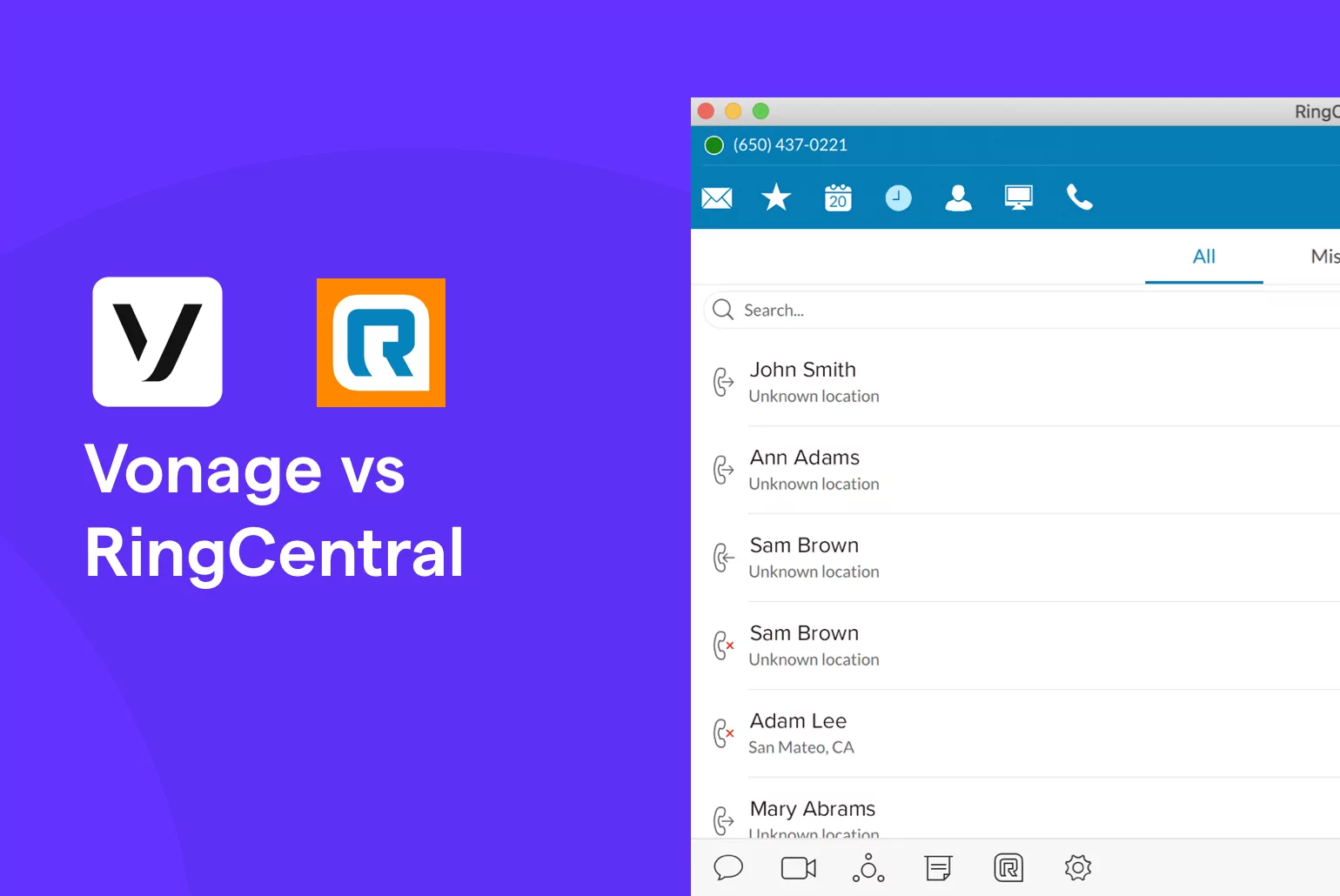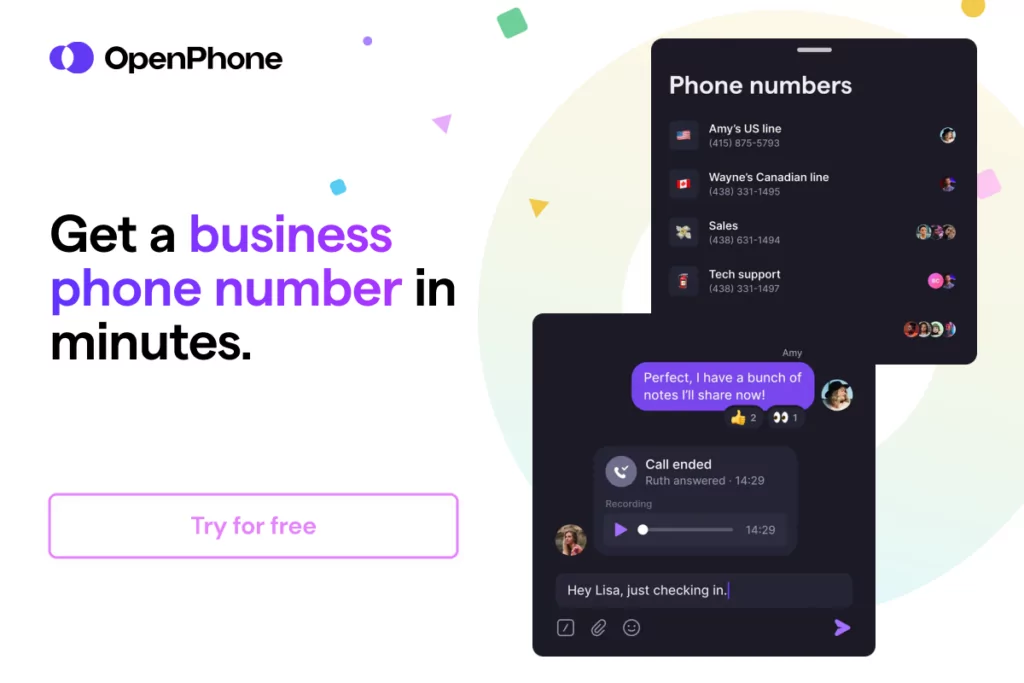Looking for a new VoIP solution for your company that better meets your business needs? If so, Vonage vs RingCentral may have risen to the top of your consideration list due to their long lists of features and prices that reflect your team size.
In this comparison, we’ll take you step by step through what Vonage vs RingCentral has to offer. As we’ll see, complexity doesn’t necessarily mean quality.
We’ll also introduce you to a VoIP business phone system you might not have considered and can be a strong fit.
Vonage vs RingCentral: Which solution best meets your needs?
Both Vonage and RingCentral try to cater to businesses of all sizes, from one-person operations and small businesses to enterprise companies with a thousand or more employees.
These VoIP phone systems position themselves as unified communications platforms or UCaaS. They offer everything from phone service to video conferencing to call center features.
But are the features, benefits, and prices the right fit for businesses of any size? Let’s compare Vonage vs RingCentral on their pricing, features, and integrations to see how they stack up.
Keep in mind Vonage has many types of phone service products. For this comparison, we’ll focus on Vonage Business.
1. Pricing: How do their pricing plans compare?
Winner: Vonage
You won’t find a straightforward price list from either Vonage or RingCentral. That’s because both business VoIP providers base their prices on the number of users on your team.
With Vonage, if you’re a small business you’ll see you’re not getting the most friendly pricing upfront. Your monthly price per user only drops when you have at least five users (their basic plan starts at $17.99 per month for teams of 5-19 users) and again when you have 20. You’ll have to contact sales if you have more than 100 users.
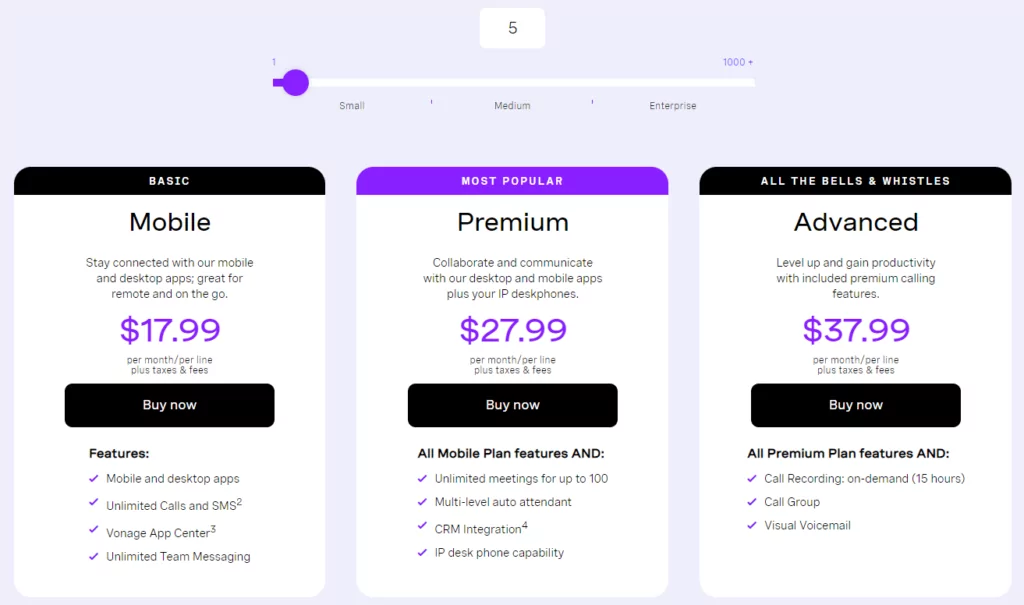
Watch out, though: Vonage has lots of hidden add-on fees throughout their product. You’ll pay extra for things like call recording ($49.99 per month) and voicemail transcription ($4.99) each month if you need them.
RingCentral’s plans only get more affordable when you add your second user or your hundredth. Once you exceed 20 users, however, you can no longer access the Essentials plan, RingCentral’s lowest-cost pricing tier.
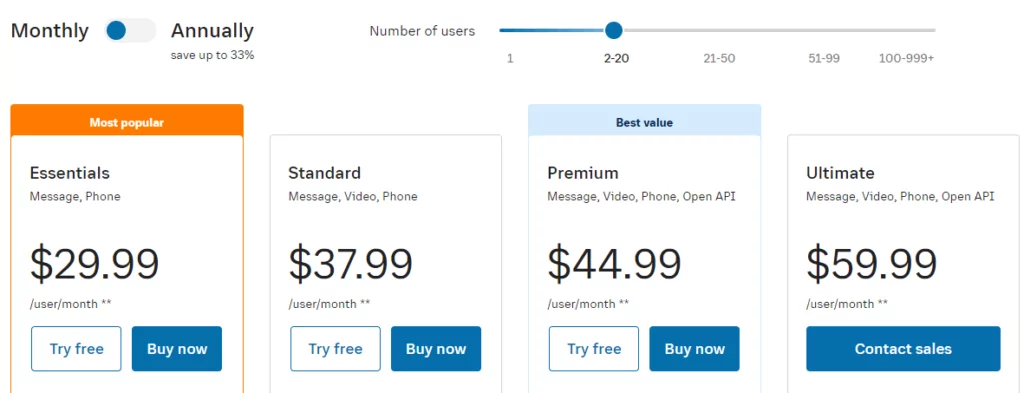
In terms of monthly cost, Vonage is a more affordable solution than RingCentral. Even if you pay for a full year of RingCentral upfront, your monthly cost will still be significantly higher than Vonage.
When it comes to fees for extra phone numbers and similar add-ons, comparing, at least Vonage vs RingCentral, RingCentral tends to be more affordable. For example, you’ll pay just $4.99 per month for extra phone numbers with RingCentral, but $14.99 for the same thing with Vonage.
2. Features: Which platform gives teams the most?
Winner: RingCentral
Vonage and RingCentral share a limitation right off the bat: your free business text messaging is restricted to the US RingCentral also doesn’t support MMS messaging for Canadian numbers.
If you’re looking to expand your business throughout North America, that’s a big cost to consider.
In general, you’ll find a lot of virtual PBX-related features with these VoIP services. Think of functionality like call forwarding, call monitoring, and call routing.
When it comes to other features, RingCentral offers a lot more than Vonage, nearly justifying its higher price tag.
The problem? Many essential features are locked behind more expensive subscription plans. You’ll need at least their upgraded Standard plan to access features like call recording, auto-attendant, and audio and video conference calling.
Even higher-tier plans come with some unexpected limitations. On RingCentral’s base plan, you’ll only get 100 toll-free minutes per month. (After that, you can expect to pay nearly four cents per minute for toll-free phone calls.) And you’ll have to pay for at least the Premium plan to access real-time analytics.
One last thing to consider: because RingCentral has so much functionality, you run the risk of paying for a more expensive plan with a lot of features you’ll never use. Some features feel more geared toward a call center than a typical office.
Vonage doesn’t do much better. You’ll pay extra for add-on features, and in some cases you may need to upgrade your plan in addition to paying the add-on fees.
Many Vonage features are also limited to US-based customers or interactions. If you’re outside the US, you won’t be able to use business text messaging, toll-free numbers, or the click-to-dial feature.
3. Integrations: What tools work well with each VoIP solution?
Winner: Vonage
Both Vonage and RingCentral offer a good selection of business tool integrations to help your business run more smoothly.
The problem is that your integration options might be limited by your subscription tier or your location. With RingCentral, you’ll have to purchase a Premium subscription or higher to access any integrations.
Vonage offers integration access on its lowest tier, but you’ll have to upgrade for CRM options like Salesforce. Some integrations, like Zoho and Microsoft Dynamics, unfortunately, are only available in the US
While both Vonage vs RingCentral offers an impressive library of integrations, in practice it becomes pricey and/or confusing to take advantage of the integrations each provide.
Vonage vs RingCentral: A better business-friendly VoIP solution
By now, you’re probably wondering if there’s a VoIP solution out there that keeps everything simple and straightforward for you and your business.
Luckily for you, there is.
Let’s take a look at OpenPhone and how it works as a streamlined communications platform for your business.
1. OpenPhone offers business-friendly pricing
OpenPhone offers straightforward pricing plans with easy-to-understand benefits for small businesses. You won’t be charged more per user if you have a small team, unlike Vonage and RingCentral. Plus compared to RingCentral’s base plan, you won’t be forced to upgrade if you have more than 20 teammates.
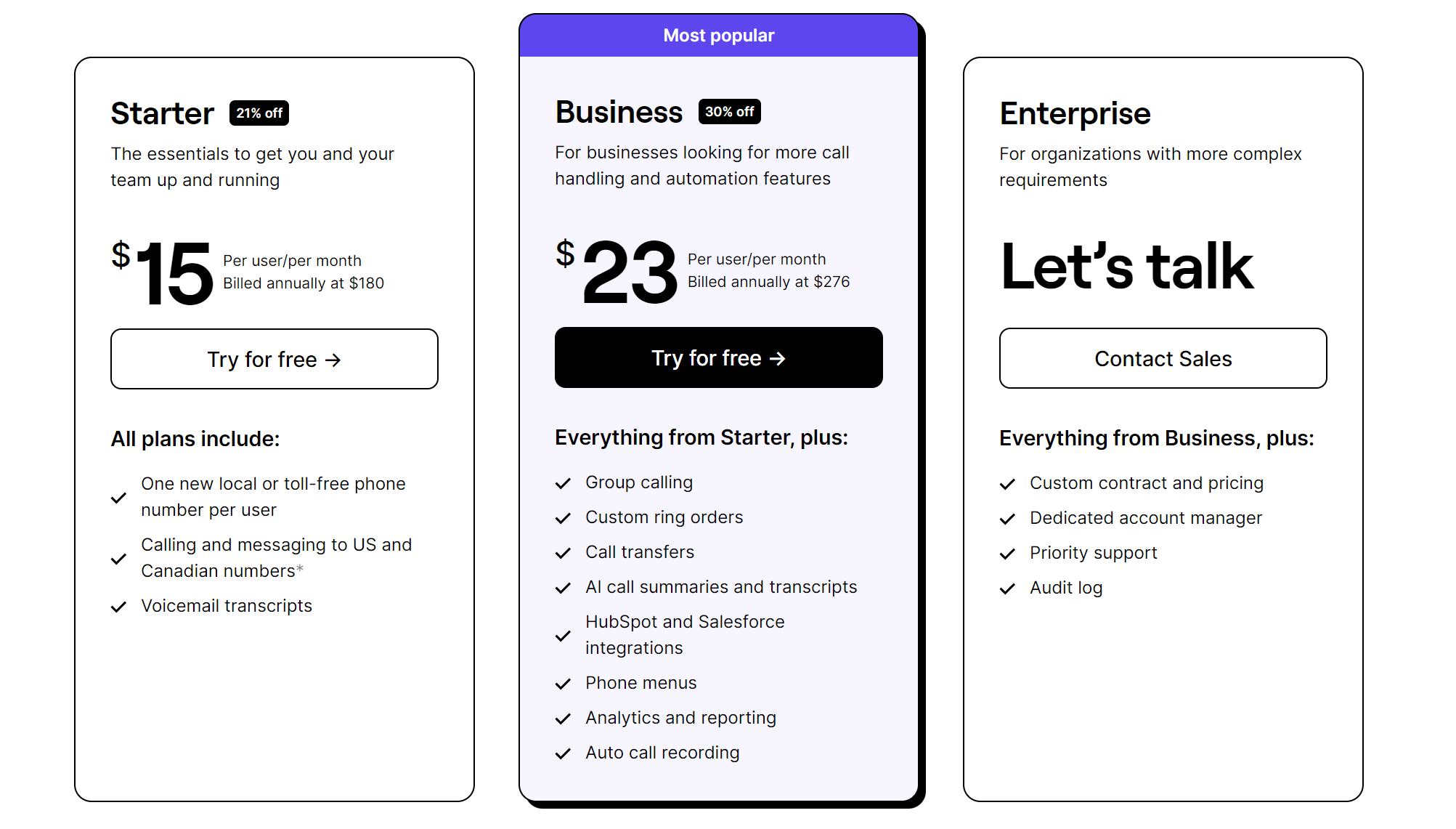
OpenPhone’s Starter plan is packed with essential features like shared phone numbers, call recordings, and voicemail transcription. You’ll get free calls and texts in the US and Canada, which you can make from either the desktop or mobile app.
The Business plan adds a few more features. You’ll access call transfer, advanced IVR features, and analytics tools.
OpenPhone offers a few add-ons as well. If the amount of numbers on your team’s account exceeds the user count, you’ll pay just $5 per number per month for an extra toll-free or local number. International calling and texting are both also available at competitive rates at a fraction of the cost of traditional wireless carriers.
These add-ons let you customize your plan to work best for your business needs. All add-on fees are transparently listed on the pricing page, so you don’t have to worry about hidden charges sneaking up on you.
2. Build your presence in North America
OpenPhone’s base plan includes free calls, SMS, and MMS to the US and Canada. Unlike Vonage, your business texts won’t be limited to the US, and unlike RingCentral, you’ll be able to send MMS messages from Canadian phone numbers.
Along with US and Canadian numbers, you can get a US or Canada-based toll-free number from OpenPhone even if you don’t live in North America. It’s the perfect entry into these markets if you’re looking to expand your business operations there. Many remote businesses also use OpenPhone to call and text their US and Canadian clients without having to pay long-distance fees.
3. Get the tools you need to be collaborative and responsive
OpenPhone’s call management features help you communicate better with both your team and your customers.
You’ll find call recordings and voicemail transcriptions on OpenPhone’s Starter plan — features you’ll have to upgrade or pay extra for compared to Vonage vs RingCentral. (RingCentral offers voicemail transcriptions on the base plan, but you’ll have to upgrade for call recording features.)
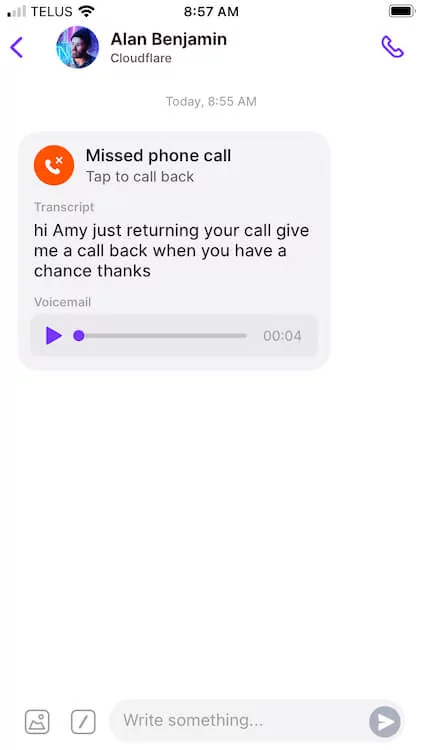
As you respond to your customers, you can use OpenPhone features like snippets and auto-replies to address their questions and needs more quickly than ever.
With snippets, you can save commonly used responses (like answers to FAQs) to be used over and over again by anyone on your team. It saves time and makes sure your team presents consistent messaging.
With auto-replies or even automated SMS through Zapier, you can talk to your customers even when you’re not working. Tell customers when they can expect to hear from you or offer them additional resources to keep them happy in the interim.
If you’re sharing a number with your team, you’ll be able to see all the activity for that number in your shared number inbox. You can see conversation history or whether a team member is actively on a call with a customer.
These features, as well as other collaboration tools like threads and mentions, help your team get on the same page when it comes to communicating with clients. You won’t duplicate work or miss calls. You can even get input from other team members on a tricky client case if needed.
4. Integrate your most important business tools
You can connect your essential tools to OpenPhone on the Starter plan. With integration options for Slack, Gmail, and Zapier, you can combine all of your communication needs with other business tools in your tech stack. Plus, stay in the loop or store updates based on specific events in OpenPhone using Webhooks.
OpenPhone also offers a Hubspot CRM integration on the Business plan letting you:
- Automatically push all phone and text conversations with contacts into HubSpot
- Sync your HubSpot contacts with OpenPhone
- Use custom activity types if you have a more customized setup of HubSpot
Integrations like these help you consolidate your work into a single app or window. Rather than wasting time switching between applications or manually transferring information between tools, you can bring everything together seamlessly.
Compare OpenPhone vs Vonage vs RingCentral on all their features in this chart:
| Feature | OpenPhone | Vonage | RingCentral |
|---|---|---|---|
| Pricing | Starts at $15 per month per user | $17.99 per user per month | $29.99 per user per month |
| Unlimited calling to US & Canada | ✔️ | ✔️ | ✔️ |
| SMS/MMS to US & Canada | ✔️ | Local US and Canadian numbers only | ✔️ |
| Voicemail transcriptions | ✔️ | Requires upgrade | ✔️ |
| Set business hours | ✔️ | ✔️ | ✔️ |
| Additional phone numbers | $5 per month per number | $14.99 per month per number | $4.99 per month per number |
| Call recording | ✔️ | $49.99 per month | Requires upgrade |
| Shared phone numbers | ✔️ | ✔️ | Up to 20 users |
| Auto-attendant (virtual receptionist) | ✔️ | Requires API | Requires upgrade |
| Auto-replies | ✔️ | ✖️ | ✖️ |
| Snippets | ✔️ | ✖️ | ✖️ |
| Slack integration | ✔️ | ✔️ | Requires upgrade |
| Zapier integration | ✔️ | ✔️ | Requires upgrade |
| CRM integration | Requires upgrade | Requires upgrade | Requires upgrade |
| iOS and Android apps | ✔️ | ✔️ | ✔️ |
| Browser app | ✔️ | ✔️ | ✔️ |
| Desktop apps | ✔️ | ✔️ | ✔️ |
Vonage vs RingCentral vs OpenPhone: What’s the best solution for you?
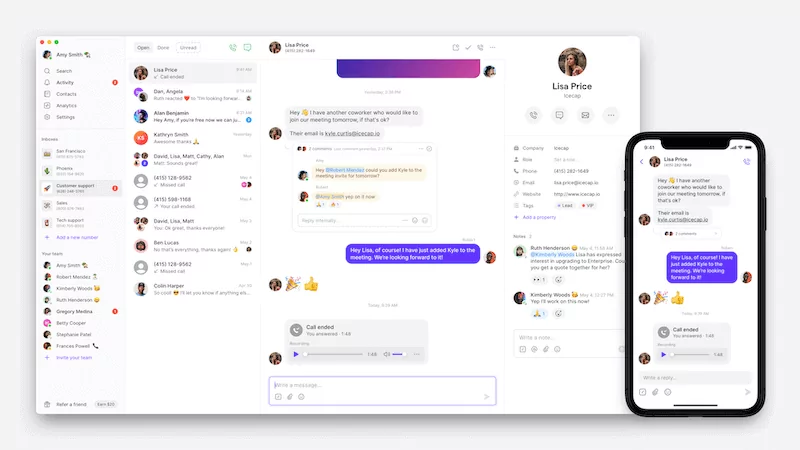
If you’re looking for a VoIP service packed with powerful features that offers straightforward pricing plans, there’s just one option for you: OpenPhone.
Our affordably priced plans come with all the features you need to manage your business communications. You’ll get the right tools for your business at the right price for you. See for yourself — start your OpenPhone free trial today.
